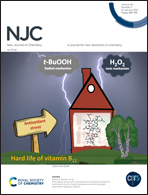[1,2,4]Triazolo[4,3-a]quinoxaline and [1,2,4]triazolo[4,3-a]quinoxaline-1-thiol-derived DNA intercalators: design, synthesis, molecular docking, in silico ADMET profiles and anti-proliferative evaluations†
Abstract
In view of their DNA intercalation activities as anticancer agents, 17 novel [1,2,4]triazolo[4,3-a]quinoxaline derivatives have been designed, synthesized and evaluated against HepG2, HCT-116 and MCF-7 cells. Molecular docking studies were performed to investigate the binding modes of the proposed compounds with the DNA active site. The data obtained from biological testing highly correlated with those obtained from the molecular modeling studies. MCF-7 was found to be the most sensitive cell line to the influence of the new derivatives. In particular, compound 12d was found to be the most potent derivative of all the tested compounds against the three HepG2, HCT116 and MCF-7 cancer cell lines, with IC50 = 22.08 ± 2.1, 27.13 ± 2.2 and 17.12 ± 1.5 μM, respectively. Although this compound displayed nearly one third of the activity of doxorubicin (IC50 = 7.94 ± 0.6, 8.07 ± 0.8 and 6.75 ± 0.4 μM, respectively), it may be useful as a template for future design, optimization, and investigation to produce more potent anticancer analogs. Compounds 12a, 10c and 10d displayed very good anticancer activities against the three HepG2, HCT116 and MCF-7 cancer cell lines, with IC50 = 31.40 ± 2.8, 28.81 ± 2.4 and 19.72 ± 1.5 μM for 12a, 33.41 ± 2.9, 29.96 ± 2.5 and 24.78 ± 1.9 μM for 10c, and 37.55 ± 3.3, 30.22 ± 2.6 and 25.53 ± 2.0 μM for 10d. The most active derivatives, 10c, 10d, 10h, 12a, 12b and 12d, were evaluated for their DNA binding activities. Compound 12d displayed the highest binding affinity. This compound potently intercalates DNA at a decreased IC50 value (35.33 ± 1.8 μM), which is nearly equipotent to that of doxorubicin (31.27 ± 1.8 μM). Compounds 12a and 10c exhibited good DNA-binding affinities, with IC50 values of 39.35 ± 3.9 and 42.35 ± 3.9 μM, respectively. Finally, compounds 10d, 10h and 12b showed moderate DNA-binding affinities, with IC50 values of 50.35 ± 3.9, 57.08 ± 3.3 and 59.35 ± 3.2 μM, respectively.
![Graphical abstract: [1,2,4]Triazolo[4,3-a]quinoxaline and [1,2,4]triazolo[4,3-a]quinoxaline-1-thiol-derived DNA intercalators: design, synthesis, molecular docking, in silico ADMET profiles and anti-proliferative evaluations](/en/Image/Get?imageInfo.ImageType=GA&imageInfo.ImageIdentifier.ManuscriptID=D0NJ02990D&imageInfo.ImageIdentifier.Year=2021)


 Please wait while we load your content...
Please wait while we load your content...